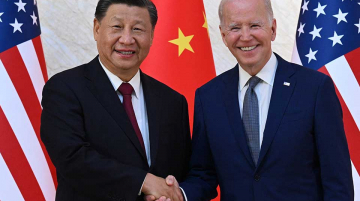
By Cecilia Springer
U.S.-China competition could be bad news for the climate.
The geoeconomic fragmentation that is driven by U.S.-China decoupling will raise costs and potentially slow the global energy transition. At the same time, countries in the Global South face a financing gap for low-carbon infrastructure and renewable energy that can meet both climate and development goals.
Given the current state of U.S.-China relations, what are effective ways the U.S. and China can engage and unlock much-needed support for renewable energy (RE) in the Global South?
A new paper by the Boston University Global Development Policy Center argues that U.S.-China coordination and cooperation could increase resources available for RE development in the Global South. In fact, the greatest gains for the climate can be had from the initiatives that require close cooperation and engagement between the two countries, which are the world’s two largest economies and two largest annual carbon dioxide emitters.
The premise of U.S.-China engagement is also underscored by the fact that American and Chinese development finance institutions (DFIs) have many complementary strengths. While the U.S.-led Partnership for Global Infrastructure and Investment may position itself as a counter to China’s Belt and Road Initiative, in fact, we argue that U.S. and Chinese DFIs have complementary advantages that can benefit developing countries most when they are coordinated and working in parallel. For example, U.S. DFIs tend to specialize in grant-based development assistance, including technical assistance, feasibility studies and training or capacity building work, while Chinese DFIs provide a wider range of lending instruments.
Based on these complementarities, we identify concrete opportunities for U.S.-China coordination on overseas RE financing across three channels: multilateral, bilateral and triangular. For multilateral engagement, options for coordination include working within the multilateral development banks (MDBs) where the U.S. and China are both shareholders; intergovernmental forums like the Group of 20 (G20) and multilateral environmental agreements like the Paris Agreement and the United Nations Framework Convention on Climate Change (UNFCCC). These existing platforms and mechanisms are a public and relatively neutral space for indirect U.S.-China engagement, and facilitated bilateral cooperation as recently as 2021.
For bilateral engagement, there is potential for expanded U.S.-China coordination on parallel investment principles and standards, trade policy, capacity building and direct financing instruments – options that vary widely in terms of current political feasibility. For example, direct bilateral financing that capitalizes on the previoU.S.ly mentioned complementarities in Chinese and U.S. DFIs could have large benefits, but would require direct cooperation in a way that is increasingly constrained by broader bilateral tensions.
Finally, opportunities for triangular engagement include joint financing commitments for RE development overseas, trilaterally coordinated project finance and the cofinancing of project funds. Triangular engagement can leverage more resources than bilateral engagement, enhance local capacity when bringing in a local partner and potentially diffuse bilateral tensions without requiring significant multilateral coordination.
Assessing these channels and options comprehensively, it is important to consider the political viability and level of direct coordination needed for the different options, as well as their potential impact on unlocking resources for overseas RE development. For example, the set of initiatives focused on investment standards and principles rank among the most viable in terms of requiring relatively minimal bilateral coordination. However, such initiatives would likely have less impact if implemented in the absence of a broader set of initiatives focused on finance.
Even amid a challenging political environment, leaders and officials in both countries should see a common interest and benefit to expanding cooperation and coordination on deploying RE projects and working in tandem with the Global South. With the clock ticking on time to limit the worst effects of climate change, and an immediate need for RE infrastructure for development, greater U.S.-China engagement is needed to expand the reach and impact of each country’s individual, and so far, insufficient finance efforts.
*
Cecilia Springer is the Assistant Director of the Global China Initiative at the Boston University Global Development Policy and an expert in China’s overseas energy and development finance. Follow her on Twitter: @Han_Cecilia.






